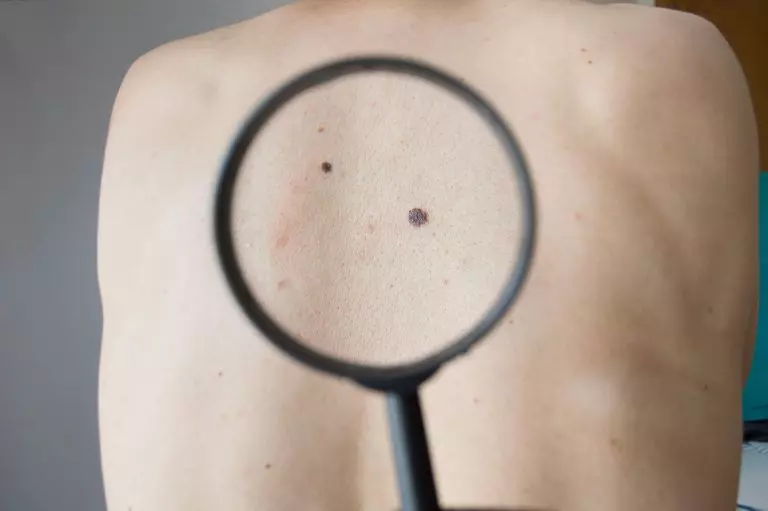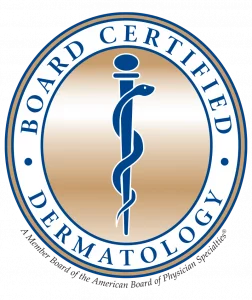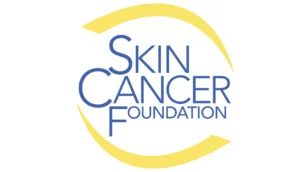Skin Cancer
Basal Cell Carcinoma, Squamous Cell Carcinoma, and Melanoma

What is Skin Cancer?
Several million cases of skin cancer are diagnosed every year in the United States. The two most common types of skin cancers are Basal Cell Carcinoma (BCC) and Squamous Cell Carcinoma (SCC). Often the exposure (e.g. sunburn) occurs years or even decades prior to the onset of the skin cancer . Those who have fair skin, blue eyes, burn easily, and have had multiple sunburns (especially blistering sunburns) during childhood, or tanning salon use are at higher risk for BCC and SCC. These forms of skin cancer may present in various ways including a non healing sore, a rapidly enlarging growth, a tender bump, an asymptomatic pink patch, and may manifest in other ways. Basal Cell Carcinoma and Squamous Cell Carcinoma are often treated with simple procedures such as electrodesiccation and curettage (scraping and burning) or surgical excision. Depending on the size and location of the skin cancer, however, mohs micrographic surgery may be recommended in order to achieve the highest cure rate with the best cosmetic result. Occasionally BCC’s and SCC’s are treated with immunotherapy or radiation.
BCC & SCC Frequently Asked Questions (FAQ)
photos courtesy of Dermnetnz.org
Rodent Ulcer BCC
Nodular BCC near the eye
Superficial type BCC
Pigmented BCC
Rapidly growing SCC on the cheek
SCC on the ear
Plaque of SCC on the arm
Cutaneous horn
with underlying SCC
Melanoma
Melanoma is the most deadly form of skin cancer, but if detected early, has a cure rate of nearly 100%. Melanoma can develop from an existing mole or present as a new growth on normal skin. It can also appear under fingernails or toenails, where there has been no sun exposure. Melanoma usually looks different than surrounding moles. Often, it is the “ugly duckling” on your skin. It may have abnormal ABCDE’s:
A – Asymmetry (the left side of the lesion does not look like the right side)
B – irregular Borders (e.g notching instead of smooth round borders)
C – multiple Colors such as light brown, dark brown, pink, and black
D – Diameter greater than 6 mm
E – Evolving, growing or changing.
People with blue eyes, fair skin, blonde or red colored hair, history of sunburns, tanning salon use, outdoor occupation, family history of melanoma or a history of atypical moles are at higher risk of melanoma.
Another useful technique for detecting melanoma is the “Ugly Duckling” concept.- The observation that moles in an individual tend to resemble one another like siblings. Melanoma tends to look different than the rest. In other words, each person tends to have one, two or three “patterns” of moles that look similar to one another. The ugly duckling looks different than the rest and is the “outlier.” If a patient sees a lesion on his/her skin that looks unique, he/she should bring this to the attention of a dermatologist.
Asymmetrical black colored
plaque with off-centered
prominent nodule and irregular borders
Asymmetrical multicolored
plaque with irregular borders
measuring 10 mm
“This tiny brown dot was a new growth on a
60 year old gentleman and was astutely
diagnosed by Dr. Craig Singer as a melanoma
using a dermatoscope.”
Dermoscopic appearance of Melanoma
Instrument used to detect melanoma at its earliest stage
Preventing Skin Cancer
Preventing, detecting, and treatment of skin cancer begins with both self-examinations by the patient and examination by a dermatologist. If you have a skin lesion that won’t heal or looks different than the rest of your moles, or you have a lot of moles, it is a good idea to schedule a visit to your dematologist. Dr. Craig Singer routinely performs full body skin examinations for his patients using a dermatoscope in order to detect skin cancer at its earliest and most curable stage. Sometimes digital photography is used to monitor skin lesions.
 Examination by Dr. Singer using a dermatoscope
Examination by Dr. Singer using a dermatoscope
Sydney Australia circa 1900. Note the full clothing worn to the beach. These people are well protected from the sun!





















